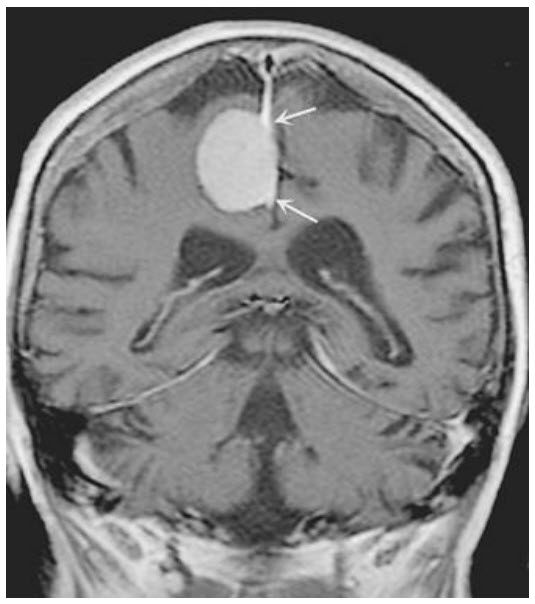Question 5#
An 82-year-old woman is evaluated for progressive dementia. She is on no medications; the family has not noticed urinary incontinence or seizure activity. Her MMSE score is 21 out of 30; she has no focal weakness or reflex asymmetry on physical examination. MR scan shows a 2.4-cm partly calcified, densely enhancing mass near the falx (shown below). There is no surrounding edema or mass effect.

What is the best approach to this patient’s management?
A. Neurosurgical resection of the massB. Radiation therapy to the mass
C. Serial CT scans and cholinergic treatment for the dementia if indicated
D. Ventriculoperitoneal shunting
E. Phenytoin and watchful waiting
Correct Answer is C
Comment:
This patient has an asymptomatic meningioma, the commonest CNS tumor. The radiographic picture of a densely enhancing tumor near the surface of the brain is essentially diagnostic, and biopsy is not necessary. An occasional patient will have bony overgrowth of the skull as a result of the hypervascular tumor; such a patient may notice a change in the contour of the skull. Almost all meningiomas are benign and grow slowly. Many are discovered incidentally during CNS imaging for other problems. While large or symptomatic meningiomas are usually treated with surgical resection, this patient’s tumor should be followed at 3 to 6 month intervals with serial CT scans. Radiation therapy is unnecessary. Ventriculoperitoneal shunting would be indicated only if neuroimaging studies showed hydrocephalus. Phenytoin is used if seizures occur; seizures are less common in meningioma than in glial tumors that arise within the brain parenchyma. This patient’s tumor would not account for her intellectual decline (bilateral cortical disease is necessary to affect higher intellectual function), and craniotomy with resection in the very elderly often causes more problems that it treats.